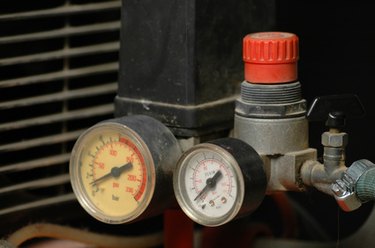Things You'll Need
Paint or stain
Thinner or reducer
Air compressor
Wet-dry sandpaper
Rag

Although there are many sprayers on the market today, many professionals still use a version of the original siphon feed gun developed by Joe Binks for the 1896 Chicago World Fair. The cup on a siphon gun is located below the nozzle, and pressurized air creates a vacuum that sucks paint up to mix with it and create a fine spray. Paints that are sprayed with a siphon feed gun typically contain volatile solvents. When they evaporate, the paint hardens into a glossy, dust-free surface. It takes a little practice to get the best results.
Step 1
Pour your paint or stain into the cup of the siphon feed spray gun, filling it about two-thirds full. Pour in an appropriate amount of thinner or reducer; check the label for the amount to use. Some products, like two-part urethane, have to be thinned with a specific amount, while others, like nitrocellulose lacquer, do not have to be thinned.
Video of the Day
Step 2
Screw the cup onto the gun. Plug the gun into an air compressor and turn on the compressor. Press the trigger on the gun to test the spray pattern on a piece or cardboard or old wood. Add more thinner if you aren't getting enough spray to make a wet coat of material when the spray tip is six to eight inches from the surface being painted.
Step 3
Hold the gun upright so the tip is pointed just past the edge of the surface you want to paint. Pull the trigger and move the gun laterally or vertically in a steady motion while you keep the trigger depressed. Spray from one edge to the other edge of the surface, then back again, overlapping the spray pattern by about half the width on each pass. Rotate the tip of the gun as needed to produce a fan that splays out perpendicular to the motion of the gun.
Step 4
Move the gun more slowly, or hold it closer, if the spray does not leave a wet coat on the surface. Move more quickly, or hold the gun farther away, if the coating drips, sags or separates. You may need a less-volatile thinner if the surface is grainy or dusty after you spray, but you can't move closer or spray more slowly without the finish running.
Step 5
Let the surface dry after you spray a full coat. Sand it with fine-grit, wet-dry sandpaper. If have drips, wait for them to completely harden before you sand them, then work them down as flat as possible.
Step 6
Spray a second coat, then let it dry and sand it as before. Continue adding more coats, sanding in between, until you are satisfied with the finish. Some materials, like two-part urethane, may require only two coats, while others, like lacquer, have to be built up with several coats to get the best results.
Step 7
Fill the cup with thinner after you have finished a session and spray it through the gun for about 30 seconds. Remove the spray tip and drop it in the cup. Let it soak for 10 to 30 minutes before wiping it off with a rag.
Tip
Drips and separation may be caused by wax or silicone on the surface you are spraying. You'll have to clean these materials off with an appropriate cleaner before you'll get good finish results.
Warning
The solvents in spray lacquer and urethane are toxic. They can damage your lungs and central nervous system. Always wear a respirator when spraying and keep the area in which you are working well ventilated.
Video of the Day